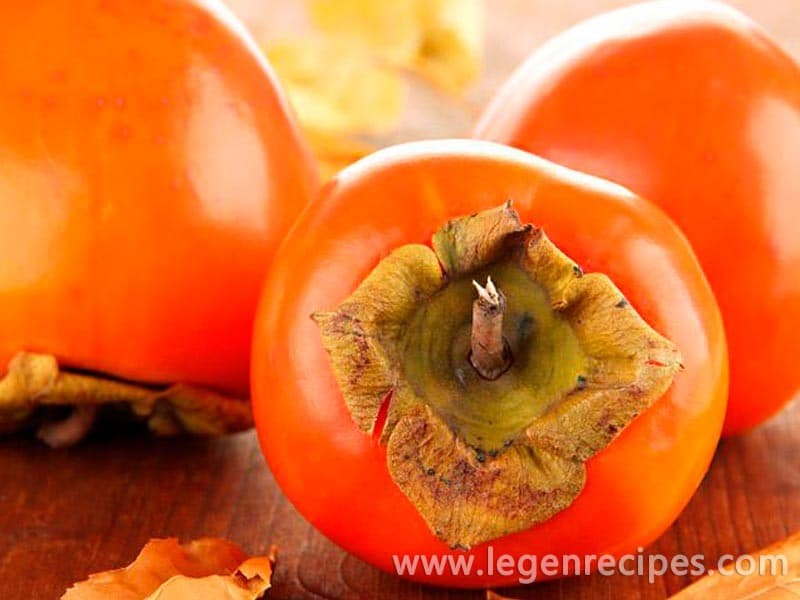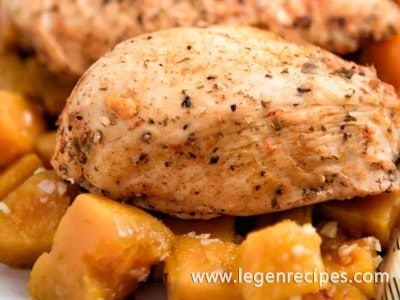With the arrival of November on the shelves of markets appears fresh persimmon – a real autumnal fruit, both in color and in season. It is tart and astringent, and sweet – and depending on the varieties require different treatment.
We often hear that the persimmon comes from the Far East – from China and Japan. This is not entirely true, because in Australia, and America has its own kinds of persimmon. However, what the people of China and Japan since ancient times to pamper yourself tender fruit pulp persimmon culture – indeed true. It is also true that it was a persimmon in the XVIII century was introduced into Europe. Nevertheless, the inhabitants of Western Europe for the first time met with persimmons are not in the East and in America. Due to the Indians they learned: it is necessary to wait for the leaf fall to gray on the trees were just hanging bright orange fruit, as if tied to strings. Later it turned out that many varieties of persimmons growing on other continents, including the rather broad areas in Asia.
Persimmon is very useful. It compensates for the shortage of vitamins and minerals in the body – in the first place, vitamins C, D, beta-carotene, B, iodine, potassium, magnesium. It gently stimulates digestion by dietary fibers which are contained in it in large quantities. In addition, dietary fiber delay absorption of sugar and cholesterol lowering absorb contaminants, including heavy metals. In the end, 100 grams of persimmon about 70 calories, but eating a little thing or two, you will long to feel satiated.
The types and grades
Persimmon varieties in the world, there are about two thousand. It can be from red to dark brown, from perfectly round and heart-shaped, to nearly square and flattened. And weighs in different ways – from 60 to 500 grams.
Biologists are several species of wild persimmon – date-plum (Diospiros lotus, the birthplace – the Far East), persimmon virgin (Diospiros virjiniana, homeland – North America), persimmon East (Diospiros kaki, homeland – Asia), black sapote (Diospyros digyna, homeland – Central America), and others.
All cultivars are derived from persimmon Virginia and Oriental persimmon. Cultural persimmons in many countries, conventionally divided into ranges – change color when ripe and a constant – not me. In Russia and CIS countries, this classification is slightly more complicated and divide all the persimmon cultivars into three groups: tannidnye (or constant) that keeping up a constant tart varieties; bestannidnye (or sweet) that keeping up a constant sweet varieties; and varying (prilled or chocolate).
In the minds of the ordinary buyers all Persimmon divided into two types: astringent and nevyazhuschaya. Astringent varieties are edible only when they are fully ripe – in the case of some varieties to nearly gelatinous state.
But in the popular Russian varieties of fruit wren and close to it the variety of persimmon can be eaten even not quite ripe: they do not knit. Persimmon, which in Russia is known as korolёk officially known as the Class hiakume and at one time was derived from the eastern persimmon.
In Spain there are persimmons, protected geographical name, – fruit varieties Rojo Brillante (as derived from the eastern persimmon) the geographical name Kaki Ribera del Xúquer PDO. They are big, bright orange, with a tight-skinned, very sweet, juicy, not binding (since sold only in mature form).
Israel has grown persimmon varieties Sharon (Sharon Fruit). This is also a cultivar eastern persimmon, which is very little tannin. Sharon tear the tree ripened and then artificially accelerate the ripening of the fruit, while removing excess tannins using fruit fumigation gas (the method of processing the fruit is considered to be harmless).
In Central America, known persimmon black sapote (Diospyros digyna), it also totolkuitlatsaputl, black persimmon (Black persimmon), chocolate persimmon, black apple, chocolate pudding (Chocolate pudding fruit). When ripe, the fruit is smooth thin green peel becomes brownish-green. Inside the fruit – the glossy black-brown jelly-like flesh with a sweet flat stones.
How to cook
More often eat fresh persimmons. However, it make excellent salads, appetizers, desserts and pastries, cocktails and other beverages. With persimmons can be cooked very interesting meat dishes.
In the East is very popular Dried persimmon. In Yaponiieё called hoshigaki, China – Shi-Bing, in Korea – gotgam, Vietnam – ho hong. Dried persimmon is eaten as a snack, dessert, used to prepare various dishes (about the same as the other dried fruits). In Korea, dried persimmon fruit used for the manufacture of traditional Korean spices sujeonggwa, and ripe fruits are used for fermented vinegar of persimmon gamsikcho.
In Taiwan fruit varieties binders in sealed jars with lime water to get rid of the bitterness. Such preformed persimmons sold as crisp persimmon persimmon or water.
In the US particularly fond of persimmon pudding, pumpkin pie-like, which is eaten with whipped cream.
In some parts of Manchuria and Korea, dried persimmon leaves are used for making tea. His Korean name – ghamnip cha.
Season
Persimmon season starts in late October and lasts until December. The most recent seasonal fruits persimmon can be purchased at the beginning of January. In these months in Russia comes mostly persimmons from Uzbekistan and Azerbaijan.
From December to February in Russia delivered persimmons from Israel, in March and April – from South Africa.
How to choose and store
The first impression of persimmon can be deceptive: attractive-looking fruit may be sweet, though, but totally inedible. The fact is that as long as persimmon fruit ripen, they contain tannins – is they who provide the specific “binding” effect. Guaranteed sweet, tender, nevyazhuschaya can only be fully ripe persimmon. But how to recognize a ripe and unripe fruit?
Absolutely sure of ripeness persimmons can be those who live in the southern latitudes. For example, in Tuapse bright lights of orange persimmons hanging on the trees until the New Year. And it is fully ripe, and chill it manages to grab. But “northern neighbors” need to know a few rules.
All varieties of persimmon are divided into two types – “normal”, or persimmon itself, and the “wrens”. Plain taste astringent persimmon loses only after full maturity, when its flesh becomes jelly-like consistency.
Korolёk not knit in principle: it is always sweet and tender, even if a little immature. However, there is one “but.” If there is pollinated and seeds were formed, the “wren” matures strong, sweet and delicious, inside – brown (for this it is called “chocolate”). If there was no pollination, seeds are not formed, and instead of chocolate, “wren” obtained tart, astringent fruit. It is nutritious, but pretty tasteless. And from the ripening of taste is independent: tart can be early-maturing and mid-season and late-ripening varieties.
Try to choose korolёk with soft drums. The main thing – look at the stalk: the leaves and the stem itself must be dry and brown.
Korolёk can be identified by the characteristic red-haired dark skin and brown color with even darker veins pulp. As a rule, small round fruits.
Amazing taste persimmon varieties, “Shahin” – a bright, large, heart-shaped. But this is not “wren”, which means that if unripe fruits, they taste can be astringent. Sang “Shahin” can be distinguished by the translucent skin of thin black rings: the more, the more ripe persimmon.
Ripe persimmons should be soft, smooth, shiny, thin translucent skin.
The astringent taste is not peculiar to the Spanish persimmon – a large, bright orange, thick and sweet. Israel’s Sharon persimmon variety also contains very little tannin.
Here are a few ways to help persimmon ripen.
1. Put it in a plastic bag with an apple or tomato: these fruits emit ethylene gas, which will cause the persimmons ripen faster.
2. hold for 10-12 hours persimmon in warm (30-40 ° C) water – tannins and consequently leave astringent taste.
3. pinned solid needle fruits dipped in alcohol.
4. Astringent persimmons can be frozen, dried or povyalit. Dried persimmon absolutely knits, but if it is wet, tart taste bad can recover.
Just bought a persimmon can be stored in the refrigerator in conjunction with other products, but such storage, the fruits should be consumed within three days.
Extend the freshness of persimmon can help lower the temperature from 0 to -1 degrees: so the fruit will lie about three months. Humidity should be at the same 85-90%, if the humidity level is lower persimmon begins to wrinkle and high humidity, the fruits covered with mold.
You can store a persimmon in the freezer. Fast freeze allows you to keep all the benefits of persimmon. And this goes all the way storage astringent tartness of the fruit, they are much tastier and stored for about six months. Persimmons can be frozen in a sugar syrup, after putting the fruit in jars. Persimmon thaw at room temperature. However, thawed persimmon pulp becomes too soft, so it would have to have a spoon.
Another method of storage of persimmon – is drying. To dry persimmon own, to choose the hardest fruit seedless, peel them from the skin, cut into pieces and put in the oven. Dried persimmon at a temperature of 40 – 45 degrees. During the process it is desirable to follow the readiness is determined on the eyes, it is important that the fruits are not darkened. Dried persimmon slices obtained sweet and fragrant, from the abundance of sugars, they can be covered with a light white coating.




